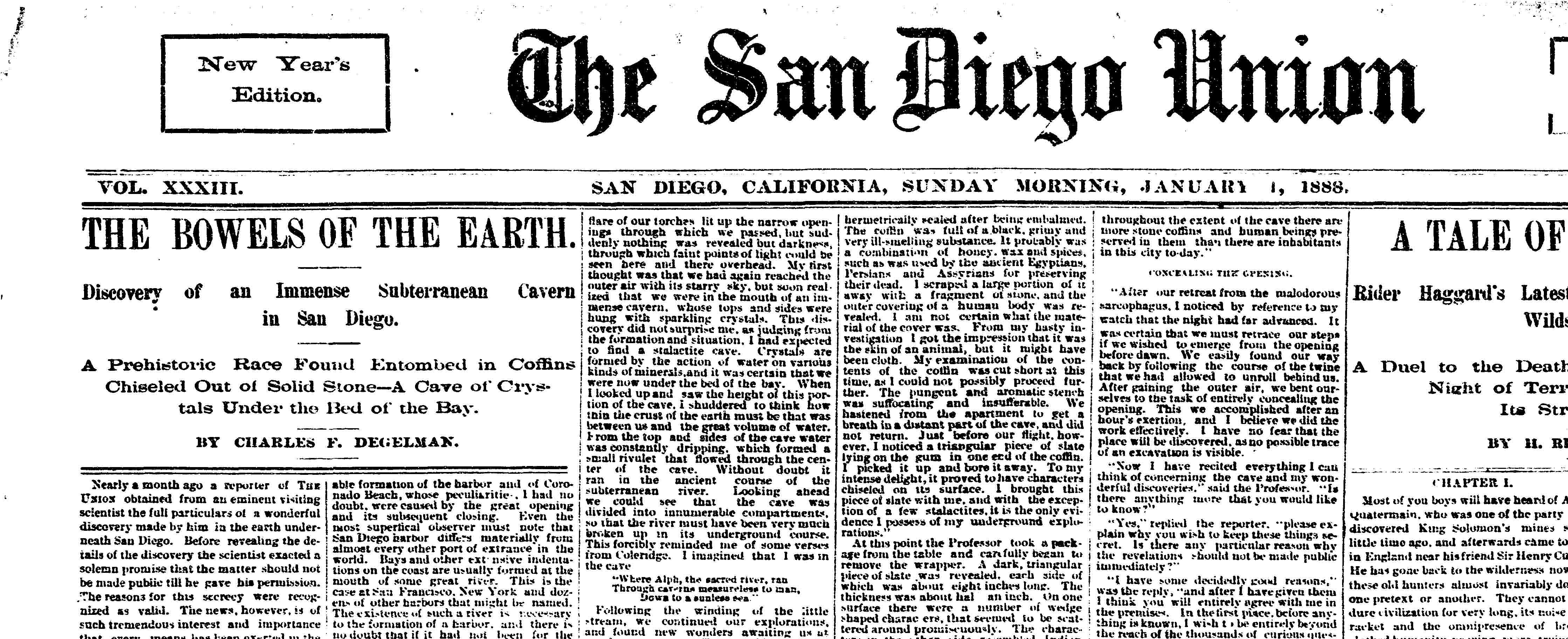 Fascinating, intriguing, or thoughtful tales about people and places in Coronado history — presented by your Coronado Historical Association
Fascinating, intriguing, or thoughtful tales about people and places in Coronado history — presented by your Coronado Historical Association
By Bruce Linder
A craze seemed to grip the country during the 1880s involving fresh discoveries of underground caverns. Incredible tales were written of new findings, expeditions of exploration, and descriptions of marvels never witnessed before. Many well-known caverns (that are national parks today) were discovered during this era and Americans were fascinated with stories and pictures that circulated widely in newspapers and magazines.
Suddenly, in the midst of this intensity, word broke of the unexpected discovery of Coronado’s own immense subterranean cavern!
Almost everyone was surprised and taken aback on New Year’s Day 1888 when a bold headline stretched across the front page of the San Diego Union reading: “Discovery of an Immense Subterranean Cavern in San Diego.”
The headline story told of the explorations of one Professor Robert E. C. Stearns, Paleontologist of the US Geological Survey who had been studying the California coast. Taken by the unique shape of San Diego Bay, he speculated that a geologic uplifting and an ensuing underground stream had caused the bay’s distinctive curve 15,000 years ago.
His studies convinced him that the mouth of that stream had closed at some point and he theorized that a great underworld cavern ran the length of the bay as a remnant of that stream.
His studies led him to Coronado where he started exploratory digs. During one of these digs, he broke through the surface into a large open void. Exploring further, he discovered an underground entrance and a pathway leading downward further into the dark.
Excitedly following a narrow underground path, the professor soon entered an immense and towering cavern, just as he had forecasted. Everywhere he looked, crystals and raw jewels shined in his torchlight. He and a companion continued to explore throughout the cavern, paying out string so they could find their way back each time to the entrance.
In one corner of the cavern (and even more surprising), Stearns found what appeared to be stone coffins with ancient inscriptions that pointed directly to a prehistoric race of advanced cave dwellers, superior to the Aztecs.
Immediately fearful of looters who might defile his “ancient city of the dead” before scientific investigation, the professor carefully hid the cavern’s Coronado entrance until proper security could be obtained.
The entrance remained hidden until, ultimately, Stearns decided to open his discovery to the public and fellow scientists. He approached the San Diego Union and spilled his story to an intrepid reporter by the name of Charles Degelman who created the front-page story for everyone’s astonished reading.
The story incited a tidal wave of excitement and chatter. “Coronado” was on everyone’s lips. The San Diego Union was flooded with inquires; the paper quickly sold out.
The only problem with this swashbuckling tale was that (wow!) it was all a hoax from beginning to end. And it was NOT a hoax engineered by the mysterious Professor Stearns but by the San Diego Union itself!
Today, of course, no respectable newspaper would ever pull such shenanigans, but back in the nineteenth century anything was fair game when it came to profits. The Union was never apologetic about their ruse even declaring a “Journalistic Success” (of all things) when they sold out the New Year’s edition.
To learn more of this entire captivating story, come to CHA’s Wine & Lecture on Friday November 14th when author and historian Jack Innis, author of “San Diego Legends” will speak on his research into this unusual tale of history.
Come visit the Coronado Museum and the Coronado Historical Association archives for this story and others. The entire compendium of intriguing “Field Guide” tales is posted on www.coronadohistory.org. © CHA




